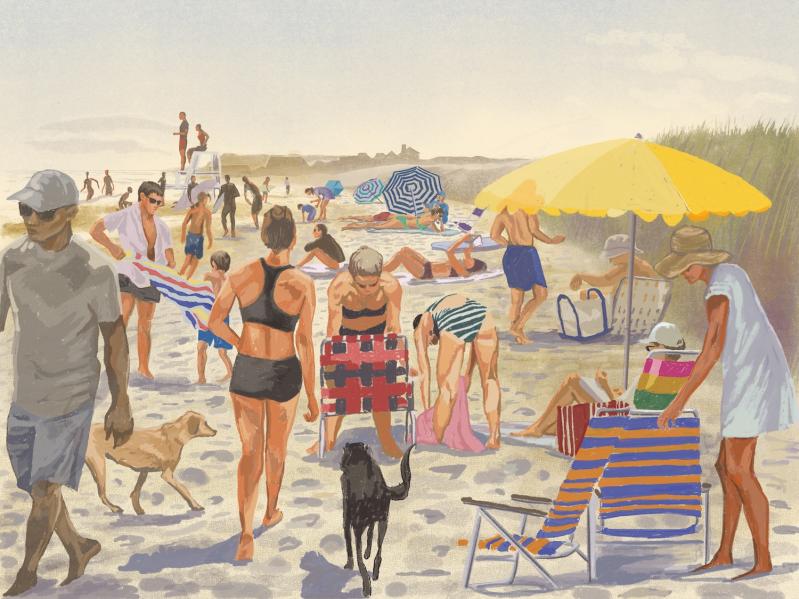Do the math, or try to; it’s a squishy question: What is the actual gosh-darn population of the Town of East Hampton during the summer?
“Spoiler alert — nobody has a great number,” says Jeremy Samuelson, head honcho at the Planning Department. “Lots of people have theories, and we are on that list.”
Here’s how to begin to sort the signal from the noise, as the data-crunchers and stats junkies like to say.
Let’s start with an easy question: What’s the full-time population of the Town of East Hampton?
The official 2020 census count was 28,500 full-time residents — only 1,517 of those in the village proper and up significantly from 21,000 in the 2010 census. But the 2020 figure may fairly be described as “controversial.” In 2022, the U.S. Census Bureau issued a report and findings that acknowledged that Latinos had been significantly undercounted in the Trump-era census.
Undercounted by a lot.
And so that first easy question is not so easy after all.
The undercount issue is especially and obviously acute in East Hampton. Samuelson estimates that there are perhaps another 7,000 full-time residents from “working class communities of color and the Latino community” here. His department, he says, felt legitimate concern in 2020 that “people just did not feel safe offering their presence.”
“If somebody forced me to offer a number of the actual year-round population,” he continues, “my guess it would be approaching 35,000.”
The 35,000 number has, since early 2022, been unofficially acknowledged by follow-on census research.
So how do we get from Question A (year-round) to Question B (summer population), without road-raging about the politicization of simple math to arrive at a fair and balanced estimate?
Fortunately, and to ground us a bit here, the town has a tried-and-true formula “going back to when I worked here 20 years ago,” says Samuelson, “where the rule of thumb is that there is a four to five multiplier that people have consistently offered over time,” to get to a summertime population range. In other words, if we accept a figure of 35,000 for the town’s year-round population, that number might bulge to between 140,000 and 175,000 during crowded weeks in July and August.
The problem is of course that if the 2020 census were correct, our population would only be about that of the town of Aberdeen, S.D., and if Samuelson is correct, East Hampton’s in summertime is somewhere between New Haven, Conn., and Fort Lauderdale, Fla. (That is, presuming that the additional 7,000 undercounted people are themselves subject to the same 4 to 5 times multiplier or one that’s greater than that range.)
The fact that there is no official hard tally is no small matter for town planners and engineers when they are asking themselves “baseline questions” about peak capacity around water use, electrical load, and cable services, says Samuelson — all the “core deliverables” of everyday life in East Hampton.
Samuelson’s conversations on population contain more hedges than you’ll find south of the Highway between Gin Beach and Southampton Citarella, but, when pressed, he estimates that the Town of East Hampton is home to between 114,000 and 140,000 summer residents — people actually living here, not just staying in hotels — this season.
Another town official is in basic agreement, but makes a further distinction: “I think I would estimate the population at around 120,000 on prime summer holiday weeks, Fourth of July and Labor Day,” says Supervisor Peter Van Scoyoc.
“I think there are approximately 22,000 residences, all of which are probably filled with friends and family those weeks,” he added.
He notes that “there was an estimate of around 78,000 prior to Covid.”
But let’s move on.
How do we even calculate these estimates, given the messy census count and all?
Historically, the town tried to get a bead on the summertime population by tracking electricity hookups and demand. Decades ago, the Long Island Lighting Company issued public reports on the total number of households it provided power to, but PSEG, its successor, doesn’t issue such reports. The town would crunch that electric-use data with transportation figures from road and rail, if not plane. The approaches were imperfect, and produced an estimated population range that, says Samuelson, “was always squishy.”
Per “signal and noise,” Samuelson says, the current method in fashion in municipal circles is to buy cellular data and compare how it fluctuates over time, but doing that may require approval from the town board. “We are probably going to want to buy some data that helps us have a more current tool,” he says.
“We can turn around to the folks who provide the cellular infrastructure, and say, ‘How many signals are there in town at any given time — pick a date, and how does that range grow and ebb?’ You can buy that data at any moment in time, and we’re going to, in rather short order.”
Yet a very savvy statistician friend of this writer, trained at Harvard but preferring anonymity (perhaps given her preference for Fire Island in the summer), warned that these population-count gambits all have their vagaries and weaknesses. Even the cellphone data has holes.
“How many cellphones per household or family?” she wonders. “Are landlines a factor?”
And here’s another: How about all those burner cellphones out there — whether used by ne’er-do-wells or immigrant newcomers? Who knows.
“It’s imperfect,” Samuelson concedes of the cellular-data methodology. But it is perhaps the best of the data-collection tools now at hand.
When thanked for his time, the gracious and knowledgeable town official, who has given a good part of his busy day to East magazine, only replies: “Yes, but notice I didn’t give you a number?”

